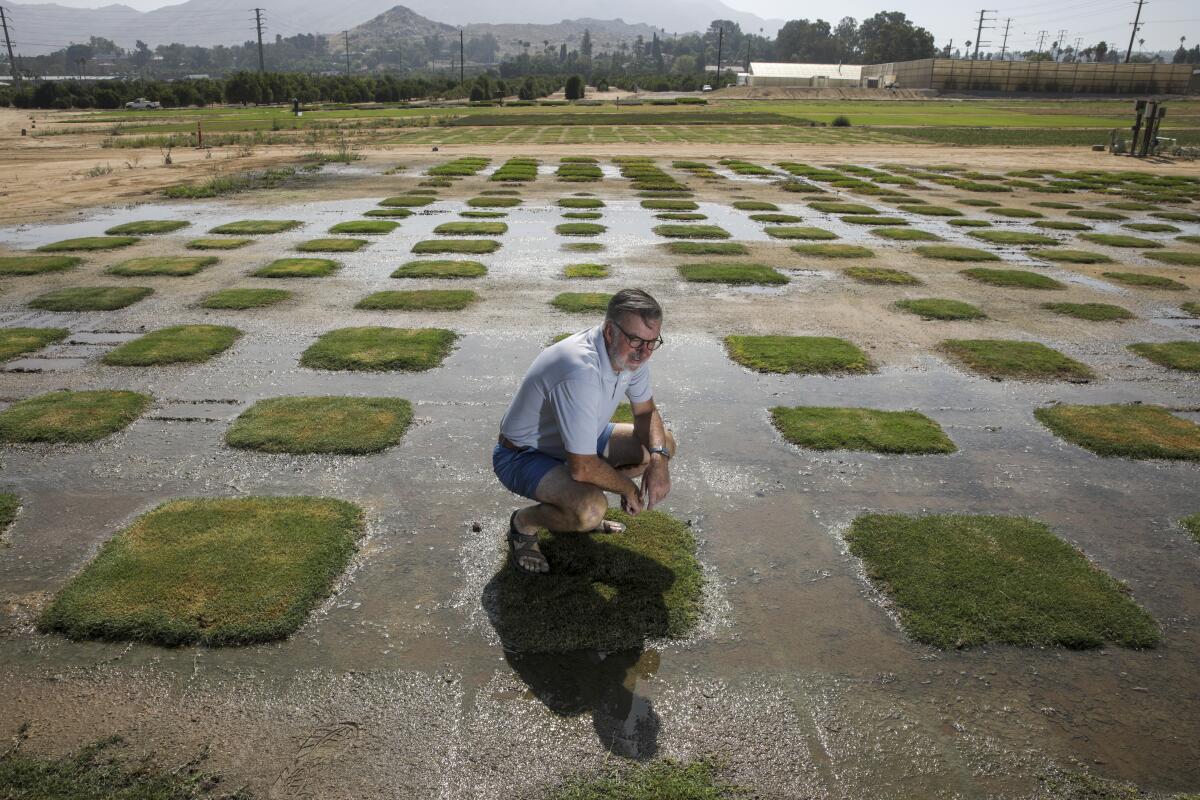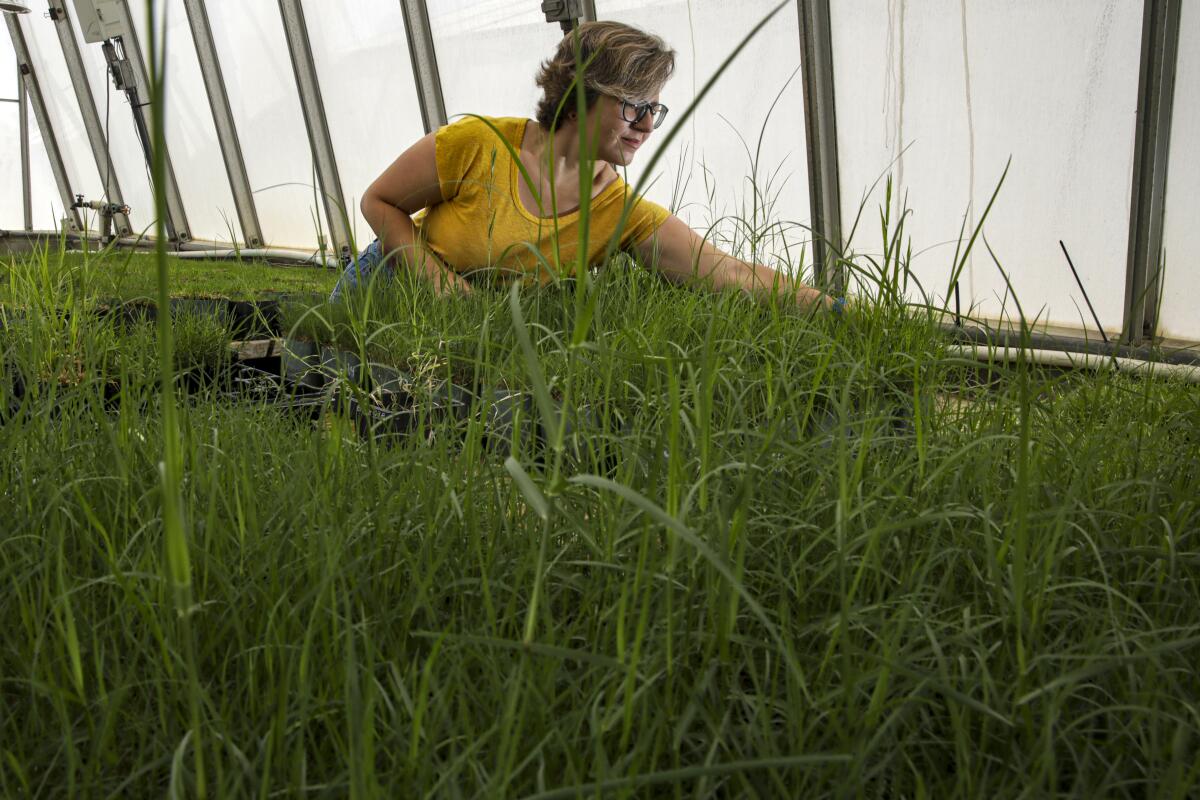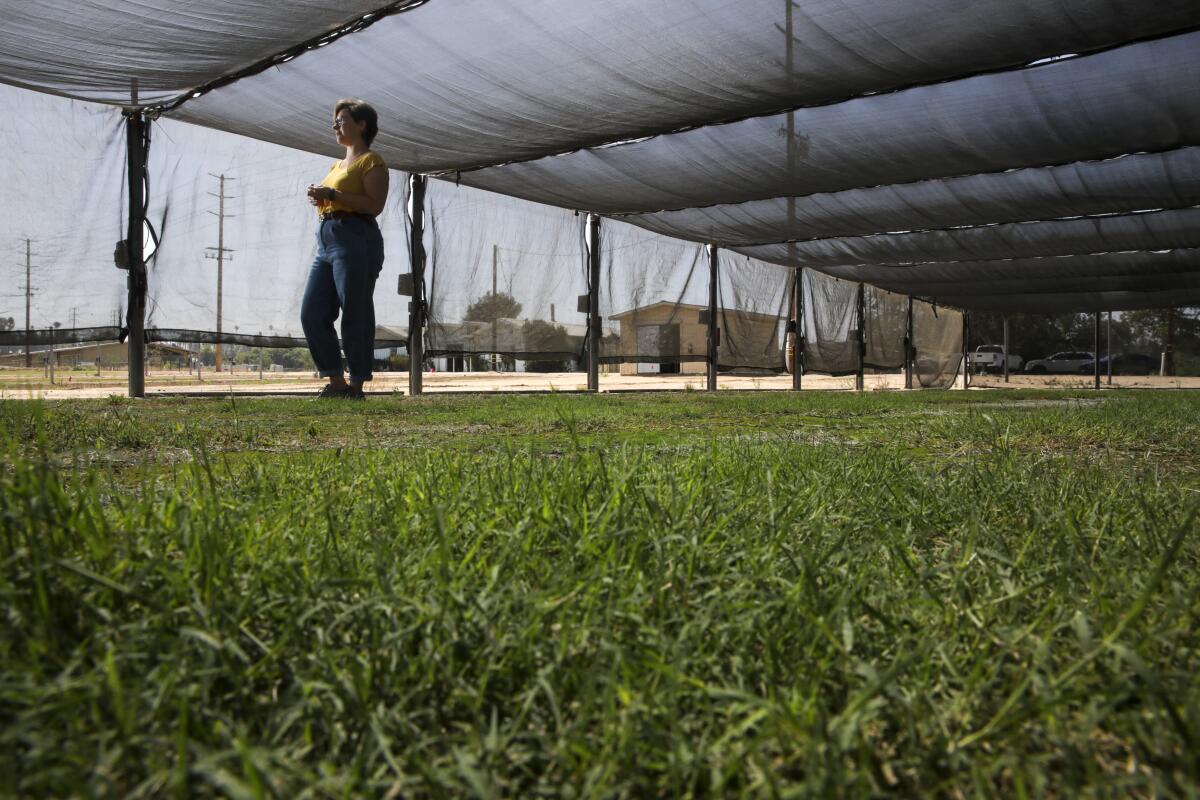Column: Has a UC Riverside researcher created the Holy Grail of drought-tolerant lawns?

- Share via
The cheerleader for Public Enemy No. 1 greeted me at the gates to UC Riverside’s Agricultural Experiment Station with a smile and some choice words.
“Every time there’s a serious drought, I’m in the L.A. Times,” Jim Baird said, only half-jokingly. “Why is it always a knee-jerk reaction? When it’s not a drought, I don’t hear from you guys. I don’t hear from the water agencies. Then we go through our wasteful ways. ‘Lawns, you’re the bad guys,’ everyone then says.”
The tall, skinny, loquacious Baird is the head of UC Riverside’s Turfgrass Research & Extension program, devoted to the study of growing and maintaining lawns. He’s the only such faculty member in the University of California system, which makes him the state’s Mark Twain of turf. Our LeBron of lawns. The Ira Glass … of grass.
Turf scientists on a quest to engineer a superlawn
I had asked to meet Baird at his workplace to see how he was weathering these times. As California and the American West suffer through the worst dry spell in a millennium and municipalities are ordering residents to let their grass die of thirst or rip it out altogether, a lawn evangelist like Baird seems as heretical a sight in Los Angeles as an Angels hat at Dodger Stadium.
Baird was not only unapologetic — he was more than happy to clap back at the haters.
“It’s not the grass’ fault,” he continued, his words rapid and passionate. “People waste the water. Government officials tell the public to water their lawns once a week. People then water for hours at a time and waste far more than they would’ve if they were left alone. You want to cut water use? Raise the prices. Educate. It’s amazing how little is conveyed to the homeowner. Instead, it’s all about, ‘We need to police you.’”
Around us, spread out over nine acres near the 215 Freeway, were lawns.
Full greens with large blades, and turf with spindly threads. Patches of grass surrounded by saltwater, and strands left to dry out. Smooth lawns and snaky ones and weedy ones and some resistant to herbicides. Some lacked nutrients; others had too many.
All served Baird’s purpose of trying to create a turf grass that might survive Southern California — not just our changing climate, but government officials and doubters like me.
We ended up at two small plots. Tufts of thin, light-green, densely packed Bermuda blades dotted the ground like a checkerboard. Tendrils spread out from all of them.
Honestly, it looked like baby artificial turf. It sure didn’t compare to the lush frontyard my dad still keeps at his Anaheim home.
But for Baird, what was sprouting before us was a botanical Holy Grail.
“This grass we’re about to release — they meet the state’s water requirements,” Baird said with the tone of someone who had just discovered a diamond-crusted perpetual motion machine. It hit all the notes he and his team had labored for over a decade to achieve.
Drought-tolerant to the point that it needs 50% less water than most lawns in Southern California. Soft enough to use for recreation. Attractive enough for customers to want to buy. Keeps a healthy green tone during the winter, when most other lawns go dormant.
“If we can get the state,” Baird said, “to have John Lawnowner get paid to take out his current grass and use one of ours …”
He let the thought linger.
“Don’t tell me that our grasses are water pigs. Don’t tell me we can’t compete in that arena.”
Baird’s grass cultivars — right now named UCR17-8 and UCR TP6-3 — were selected from more than 400 hybrids. The plot before us was planted last year, as a final exam of sorts before Baird felt confident enough to hit the publicity trail.
It’s time for their closeup.

Next week, he’ll host UC Riverside’s annual Turfgrass and Landscape Research Field Day, complete with a trade show, a barbecue lunch, a tour and a lecture to highlight the glories of UCR17-8 and UCR TP6-3.
Last month, he and his team talked about their work at the Southern California Golf & Water Summit in Chino Hills. Among those in attendance was Krista Guerrero, program manager for the Metropolitan Water District’s SoCal Water$mart Turf Replacement Program — you know, the people who want you to kill your lawn and replace it with natives.
“Jim’s research is very important to that industry that needs the changes,” Guerrero said. “That grass is excellent, and we’re so happy about that.”
It’s “absolutely a part of the solution” to combat the drought, she added.
If all goes according to plan, UCR17-8 and UCR TP6-3 will be out in limited release by 2024 — with more marketable names.
“It should be called something that means something to this region,” Baird said, now wistful. “Grasses have names like Santa Ana or Celebration, or TifTuf. We’ll get there.”
His love for lawns began at 16, as a golf course maintenance worker in Pueblo, Colo. Baird studied and taught at some of the best research universities for turf grass in the United States — Penn State, Colorado State, Oklahoma State, Auburn — before landing at UC Riverside in 2008.
Greeting him was a drought.
He became head of a program that had bred turf grass to adapt to California’s ever-changing climate for decades. Predecessors had developed cultivars that were resistant to smog and that could live under the lights of domed stadiums. Consumers had slowly switched from cool-season thirsty grasses such as fescue to warm-weather types such as St. Augustine and Zoysia.
By the time Baird arrived, the demand — nay, necessity — for lawns that were even more drought-tolerant was imminent.
“I’ve now been through three serious droughts since I’ve worked in Riverside,” he said. “This one is the worst one I’ve seen. Hopefully, things will get better. ... Removing what’s a perceived problem — lawns — might address the issue, but it doesn’t solve the bigger problem that there’s just not going to be as much water as there used to be.”

We were now in an area shaded with mesh tarps. His assistant researcher, Marta Pudzianowska, checked up on even more grassy experiments. The 38-year-old didn’t grow up with lawns in Poland, where native vegetation such as wheat and daisies were more common in yards. “Here, though,” she said with a smile, “lawns are the American dream.”
Pudzianowska took us to a collection of greenhouses, which contained hundreds of cultivars in individual nursery plots, each with a name. She lets them flower, then cross-breeds the best of the bunch.
“The best is yet to come,” Baird said excitedly, as Pudzianowska grabbed a promising specimen. “The next ones Marta brings will be even better than what we’re about to release. It’s a never-ending story. You can always improve.”
“It’s a darker color and has a higher density and a narrow leaf,” she replied. “But it’s in the greenhouse. I still don’t know how it’s going to do in the field. It might be bad. It might be very good.”
I said my goodbyes to Pudzianowska as Baird walked me back to my car.
“Are there parts of California where we don’t need turf?” he said. “Yes. But people need to understand the effects. There are consequences to that. For someone to say, ‘Rip them all out,’ it’s a little shortsighted — no, a lot shortsighted.
“I realize grass is not for everyone, but why are we singled out?” Baird concluded. “We shouldn’t send it into extinction. We just want our fair shake.”
More to Read
Sign up for Essential California
The most important California stories and recommendations in your inbox every morning.
You may occasionally receive promotional content from the Los Angeles Times.











